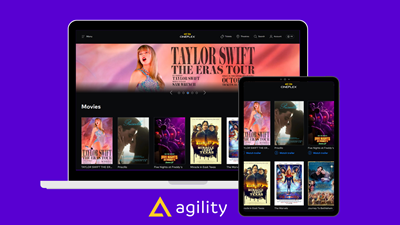Case Study: How Agility CMS Helped Scale 10 Global Sites Without Slowing Teams Down
Discover how an enterprise brand used Agility CMS on Azure to consolidate content, launch 10 global sites, and ship campaigns faster—without sacrificing governance or security.


At A Glance
A global, multi-brand organization needed to:
-
Consolidate 10+ marketing sites running on different platforms
-
Give regional teams more control without losing governance
-
Integrate with existing systems on Azure
-
Improve time-to-launch for campaigns and new markets
They chose Agility CMS as their composable content platform. The result: one structured content hub, multiple front ends, and a faster, more predictable way to grow.
In this case study, we’ll walk through the challenge, the architecture, and what changed for their teams day-to-day.
The Starting Point: 10 Sites, 10 Different Problems
Before Agility CMS, their digital footprint looked like this:
-
Multiple CMS platforms across regions (traditional + custom-built)
-
Different URL structures, content models, and workflows
-
Duplicate content everywhere — same campaigns rewritten across sites
-
Simple updates (like a global announcement) took weeks to roll out
-
Every region had its own “way of doing things,” making governance difficult
Marketing wanted:
-
Faster campaign launches and local flexibility
IT wanted:
-
Fewer platforms to maintain, stronger security, and a cleaner architecture
They needed one place to manage content and a way to roll out global changes without breaking local experiences.
Why They Chose Agility CMS
The evaluation team focused on three things:
-
Composable & headless architecture
-
API-first, structured content, and integrations that fit their Azure-first strategy.
-
Freedom to choose the right front-end frameworks (Next.js, React).
-
Hybrid editing experience
-
Headless APIs for omnichannel delivery.
-
Web Studio for editor-friendly page composition across regions.
-
Enterprise security & governance
-
Azure-based infrastructure with enterprise-grade security.
-
Roles, workflows, and environments for safe collaboration.
Relevant capabilities they leaned on:
The New Architecture: One Content Hub, Many Sites
Here’s how the solution was designed.
1. A single content hub in Agility CMS
They centralized content into one Agility instance:
-
Global content models:
-
Article, Product, Campaign, Promotion, Location, FAQ, etc.
-
Linked content for relationships (e.g., Campaign ↔ Regions, Product ↔ Category).
-
Localized fields to support multiple languages and markets.
Resources:
2. Multiple front ends, same content
Each site (global and regional) used its own front end, powered by Agility content:
-
Global corporate site and top-level brand presence
-
Regional sites tailored to specific countries and languages
-
Campaign/landing sites for launches and promotions
Most sites used Next.js, deployed to the organization’s preferred hosting, pulling content via:
3. Azure-powered operations
Agility CMS ran on Microsoft Azure, fitting neatly into their existing IT strategy:
-
Centralized security policies
-
Global availability and performance
-
Compatibility with existing Azure services and monitoring
Read more:
Governance Without Slowing Anyone Down
One of their biggest worries: “Will we lose control if we give regions more freedom?”
Agility CMS let them do both:
-
Global team
-
Owns global components, design system, and shared content models
-
Defines layouts and approved page modules in Web Studio
-
Regional teams
-
Create and manage local pages within approved templates
-
Translate and adapt global content for local markets
Key features used:
This meant:
-
Global brand standards stayed intact
-
Regional marketers could finally move faster without waiting on central IT
-
Everyone worked in one system, instead of a patchwork of tools
Day-To-Day Changes For Their Teams
For marketing & content teams
Before:
-
“Can you build this landing page?” turned into a dev ticket and sprint.
-
Updating a global message across sites was a copy-paste nightmare.
-
No clear preview for how pages would look in each region.
After:
-
Editors used Web Studio to build and publish pages with approved components.
-
Global announcements and campaigns were created once and reused across sites.
-
Local teams previewed their pages per region and device before publishing.
Relevant features:
For Developers
Before:
-
Every site had a slightly different tech stack and plugin mix.
-
Upgrades and security patches were manual and inconsistent.
-
New integrations (search, DAM, forms) meant rebuilding from scratch per site.
After:
-
They standardized on Next.js patterns for multiple sites.
-
New components could be rolled out across all sites using the same framework.
-
Integrations were wired once at the platform level instead of per site.
Helper resources they used:
For IT & Security
Before:
-
Multiple CMS instances to patch and watch.
-
Different permission models and login systems everywhere.
-
Hard to guarantee consistent compliance and auditability.
After:
-
Centralized access control with SSO and role-based permissions.
-
One primary content platform to monitor and govern.
-
Better visibility into who changed what, and where.
Helpful capabilities:
The Impact: What Changed For The Business
While numbers will vary per organization, this kind of setup typically delivers:
-
Faster launches
Going live with new markets or campaign sites in weeks instead of months. -
Lower operational overhead
Fewer content platforms to manage, patch, and support. -
Consistent brand & experience
Shared models and components ensure every site feels on-brand, even when localized. -
Better use of content
One piece of content can appear on multiple sites, in multiple formats and regions, without duplication.
To see similar stories:
What This Architecture Makes Possible Next
With 10 global sites running on Agility CMS, the organization now has a foundation for:
-
Launching new brand sites using the same content hub and patterns
-
Adding new channels (apps, in-store displays, partner portals) via APIs
-
Testing new integrations (search, AI, personalization) with far less risk
-
Supporting M&A activity by onboarding acquired brands into the same platform
This is the core promise of composable: once the foundation is in place, adding or swapping pieces gets easier over time.
For more on the strategy behind this:
-
Composable CMS Explained (and Why It’s the Future)
Considering A Similar Move?
If you’re running multiple sites across regions or brands and your current stack feels heavy, slow, or fragmented, you don’t need a risky big-bang replatform.
With Agility CMS on Azure, you can:
-
Start with one brand or region
-
Prove the model with a pilot site
-
Scale to more sites and channels at your own pace
Talk To Our Team
If this sounds like the direction you’re headed, we’d be happy to walk through:
-
Your current architecture and constraints
-
Where a composable content hub would add the most value
-
A phased rollout plan to avoid disruption
Secondary CTAs:

About the Author
Agility CMS is Canada's original headless CMS platform. Since 2002, Agility has helped companies across Canada and around the world better manage their content. Marketers are free to create the content they want, when they want it. Developers are empowered to build what they want, how they want.
- Get a demo for a personalized walkthrough.
- Try for FREE and experience Agility CMS.
- Contact us with your questions.
View Related Resources

Cineplex Entertainment: A Composable Success Story

How Enterprise Single Sign-On Makes Teams More Efficient

Key Features to Look for in an Enterprise Headless CMS

